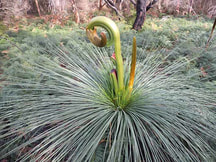
By Catherine Watson
A SURVEY of the Tank Hill Conservation Reserve nine months after fire swept through much of it reveals some rich and unexpected botanical treasures.
A SURVEY of the Tank Hill Conservation Reserve nine months after fire swept through much of it reveals some rich and unexpected botanical treasures.
Most wonderful is a big clump of grass trees now flowering and standing tall above the bracken fern. Few people even knew they were there since they were previously hidden by the bracken fern. They were the first to bounce back after the fire, revealing the first green shoots within a few days. The fire has obviously done them good, since they are all flowering and now stand tall above the bracken, which soon reappeared as well.
The week after the fires, a hopeful grass tree lover appeared with a wheelbarrow and shovel, but botanist Terri Allen, a friend of Tank Hill, politely pointed out that he would need a bulldozer to secure enough of the root system to transplant a grass tree. He left looking disconsolate and Parks Victoria has since installed CCTV cameras to ensure that no one else is tempted.
On a tour of the burnt area last week, Terri pointed out more treasures: large numbers of common bird-orchids, spreading rope-rush, weeping grass, common reeds, two groundsels, scented and swamp paperbark, sandhill sword-sedge, red fruited saw-sedge, blackwoods, austral stork's bill, prickly moses, showy bossiaea, native violets, broom spurge, common raspwort, silver banksia and spike beard heath, manna gums and narrow-leaf peppermints.
In fact, so prolific are the eucalypt seedlings that you have to concentrate not to walk on them. Most of the tree ferns have also recovered, to my surprise.
Along with the treasures are the weeds: literally billions of Montpellier broom seedlings, watsonia, blackberry, nightshade, milk thistles, cats’ ears, dolichos (also known as “dunny creeper”), clovers and capeweed.
Six quadrant sites have been marked off with steel droppers to record the results of the fire over time.
While the hillsides were the first to recover, the bottom flats where the fire burned fiercest in the swamp paperbarks, remained black and sterile for many months. They are only now beginning to show signs of recovery with some green shoots appearing.
The week after the fires, a hopeful grass tree lover appeared with a wheelbarrow and shovel, but botanist Terri Allen, a friend of Tank Hill, politely pointed out that he would need a bulldozer to secure enough of the root system to transplant a grass tree. He left looking disconsolate and Parks Victoria has since installed CCTV cameras to ensure that no one else is tempted.
On a tour of the burnt area last week, Terri pointed out more treasures: large numbers of common bird-orchids, spreading rope-rush, weeping grass, common reeds, two groundsels, scented and swamp paperbark, sandhill sword-sedge, red fruited saw-sedge, blackwoods, austral stork's bill, prickly moses, showy bossiaea, native violets, broom spurge, common raspwort, silver banksia and spike beard heath, manna gums and narrow-leaf peppermints.
In fact, so prolific are the eucalypt seedlings that you have to concentrate not to walk on them. Most of the tree ferns have also recovered, to my surprise.
Along with the treasures are the weeds: literally billions of Montpellier broom seedlings, watsonia, blackberry, nightshade, milk thistles, cats’ ears, dolichos (also known as “dunny creeper”), clovers and capeweed.
Six quadrant sites have been marked off with steel droppers to record the results of the fire over time.
While the hillsides were the first to recover, the bottom flats where the fire burned fiercest in the swamp paperbarks, remained black and sterile for many months. They are only now beginning to show signs of recovery with some green shoots appearing.